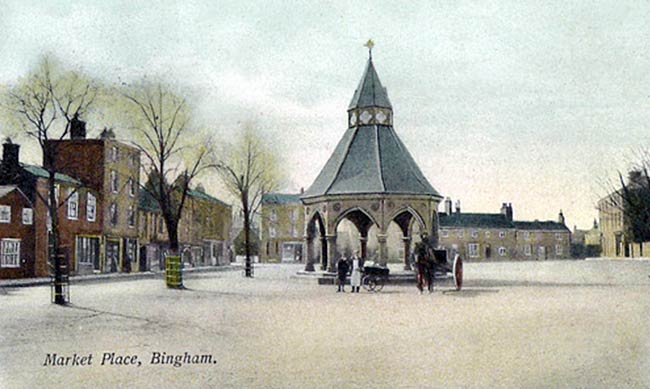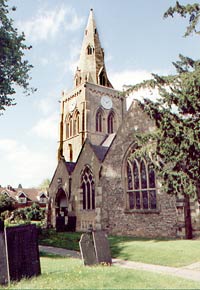< Previous | Contents | Next >
The Old-Fashioned Town in the Vale

The Market Place, Bingham, c.1910.
BINGHAM. Rich in its memories of famous folk, and treasuring an old church as full of beauty as of human story, the Bingham of today is a quiet, oldfashioned town in the lovely Vale of Belvoir. But its streets rang with the sound of horn and galloping hoofs in old coaching days, and though the marketplace is deserted now we are reminded of its busier times by the picturesque Butter Cross, erected last century to one of whom we read that "To be beloved is better than all bargains."

Bingham church in 2000.
Two of Nottinghamshire's great soldiers sleep in the church, and one of them has a place for all time in Shakespeare. Three of its rectors became bishops; another is remembered as one of the originators of the Poor Law system of 1834, the Bingham workhouse serving as a model for the Poor Law reformers of the day. The rector sleeps at Oxton, where his son Henry inherited an estate and took the name of Sherbrooke. It was another son, Robert Lowe, born at Bingham rectory in 1811, who became a brilliant Chancellor in Mr Gladstone's ministry.
A lychgate leads us to a churchyard like a garden of lawn and flowers, where many yews make sheltered walks. It is a charming setting for the cross-shaped church, its beautiful 13th century west tower and short spire equalled by few in the county. The spire has three tiers of windows. Buttresses in the middle of three sides reach the belfry windows, and others at the corners climb to the top of the tower, where a bishop and a priest keep company with two pinnacles. One of the charming things inside the church is the sight of its west lancet, curiously set in a buttress, lighting up a deep splay of wall eight feet thick.
Among the interesting capitals of the 600-year-old arcades is one with curious masks said to represent the Deadly Sins, one having foliage realistically carved as if blown by the wind from the doorway, and another, a fine example of undercutting, showing small animal heads eating the leaves. The sedilia and piscina and many windows are as old as the arcades; the east window is 15th century.
A cross-legged knight of 600 years ago, with praying hands, a shield on his arm and a lion at his feet, may be Richard de Bingham, son of the Nottingham wool merchant Ralph Bugge, who founded the Willoughby family. The fragments of another figure are 15th century. A worn floorstone in the chancel has something left of the engraved portraits of one of Nottinghamshire's most famous warriors and his wife. He was Thomas de Rempstone, who helped to put Henry the Fourth on the throne and was one of the band who set out with Henry from Brittany and landed with him at Ravenspur. The story of this adventure lives in Shakespeare's Richard the Second, where Sir Thomas's name is altered to John, perhaps for the sake of metre.
For his services Sir Thomas was made Constable of the Tower, Admiral of the Fleet, and Knight of the Garter, and he was brought here for burial after being drowned in the Thames. His son Thomas, who fought with Henry the Fifth at Agincourt, was taken prisoner and ransomed for an enormous sum; like his father, he is buried in this church, but his memorial has disappeared.
Stories of our time cling to some of the beautiful modern work enriching the church. The children gave the fine oak cover, nearly six feet high, for the Norman font, which they set on a new base. In memory of men who died for peace the massive base of the 15th century oak chancel screen was given its fine top with tracery and a beautiful cornice. Lovely glass in memory of Canon Miles shows Jacob asleep with his head on a rock, seeing in his dream the angels ascending and descending; and the face of Jacob is the likeness of the canon as a young man.
Given by the parishioners to commemorate the 700th anniversary of the church, the great oak reredos, carved and gilded, is a study in beautiful craftsmanship, and its story symbolises the history and industry of Bingham, and the church's dedication to All Saints. We see Robert Bingham, who began building the church while he was rector. Christ as the Good Shepherd, St Wolstan with a sickle, a sheaf of corn, and a fowl, remind us that this is an agricultural district. St Barbara, patron saint of weavers, holding a model of this church tower, is symbolical of the days when frame-knitting came next to husbandry here. St Hugh of Lincoln, the Madonna as patron saint of Southwell, and St Wilfrid of York with a fine miniature of his Minster, are also here. There is a row of ten quaint little people of all sorts and conditions, suggesting that saints are found in all walks of life, the company including a king and a queen, a merchant with his papers and his wife with a golden box, a shepherd carrying a lamb and a labourer his bricks, a farmer with his sheaves, a priest, a beggar, and a woman at her wash-tub.
When the war broke out and the young men left the countryside, an old craftsman took the place of a young one and fashioned the lovely oak pulpit with its traceried panels and gilded medallions of rose, shamrock, thistle, and symbols of the Evangelists, working on its mass of exquisite carving during the last days of his life, for he died a fortnight after his masterpiece was brought here.
The stalls are notable, and every choirboy on each front row sits under a canopy.
Bingham's most charming story belongs to a little old lady carved in oak near the chancel. Eighteen inches high, in bonnet and shawl, she stands with a stick in one hand and a large fish basket in the other, as she used to go about the town collecting odds and ends. She was Ann Harrison, who came to this church throughout her long life of all but a century, for she was born in 1829 and lived till 1928, out of the reign of William the Fourth into the reign of George the Fifth. All the money this devout and generous woman made from going round with her bag was put into one of the church collections as soon as it amounted to two half-crowns. After her death (she would not hear of it in her lifetime) her photograph was put at the beginning of an illuminated Book of Honour to the Fallen, which was paid for with her contributions. It rests on the splendid lectern given as a thankoffering by the men who came back.
Ann's old armchair is now in the church near her attractive little figure in oak. This chair, too, has an interesting story, for it is said that it was once claimed for unpaid chimney tax, after which it passed into the hands of the Lowes at the rectory.
In our own day Bingham was for many years the home of James Prior Kirk, who wrote stories of Nottinghamshire life and won fame with his Forest Folk. He lies in the cemetery here.
The Nottingham Knight in Shakespeare
SIR THOMAS REMPSTONE is in gallant company in the pages of Shakespeare. The scene in which John of Gaunt delivers his magnificent oration This royal throne of kings, this sceptred isle, closes as with a herald's clarion call. Harry, old Gaunt's son, and his fifteen knightly lances,
With eight tall ships and three thousand men of war,
Are making hither with all due expedience,
And shortly mean to touch our northern shore,
and Sir Thomas Rempstone (Ramston as Shakespeare calls him) is of the immortal company.
It is with no connivance of this knight of Nottingham that this land of such dear souls, this dear, dear land, is now leased out . . . like to a tenement or pelting farm. He has broad possessions in the county of his birth, and, rather than condone the avarice and lawless extortion of Richard the Second, he crossed the sea to Bolingbroke and is now on his way with him to Ravenspur, to aid him to recover his estates and to transfer Richard's crown to his own brow.
Henry kept about him the men who had hazarded all in his behalf, and Rempstone's reward was the Constableship of the Tower and the custody of Richard. He was present at the abdication, and signed as a witness the deed of resignation by which the fallen king renounced his throne.
Thereafter we see him moving in a pageant of history of the times, quelling treasonable practices in London, created an admiral and steward of the king's household, taking his place in the Privy Council. As Admiral of the Fleet from the Thames westwards, he experienced a year of strange and fatal vicissitudes. At the beginning of 1406, while crossing the Thames from Queenborough to the Essex coast, he was captured by French pirates, but was released and returned to London, taking ship again in the same year, when he was drowned.
